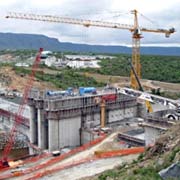
|
contents | technologies | |||||||||
| Manitowoc cranes work on largest dam in southern Africa  Ten Manitowoc cranes are working on the construction of a remote dam in South Africa. The De Hoop ("The Hope") Dam will be 81 m tall and stretch more than 1 km over the Steelpoort River in Limpopo, South Africa. It is being built for the South African Department of Water Affairs. The Manitowoc cranes on the project are a mix of Potain tower cranes, a Manitowoc crawler crane and Grove mobile cranes. The cranes perform a variety of lifting tasks, which will change as the project progresses. But all work is related to constructing the outlet works of the dam, which will require 930,000 m3 of concrete to complete. Jobs include assembling conveyors and concrete batching plants, placing shuttering and reinforced steel, installing mechanical items in the outlet works, damage recovery and pouring concrete. Ten Manitowoc cranes are working on the construction of a remote dam in South Africa. The De Hoop ("The Hope") Dam will be 81 m tall and stretch more than 1 km over the Steelpoort River in Limpopo, South Africa. It is being built for the South African Department of Water Affairs. The Manitowoc cranes on the project are a mix of Potain tower cranes, a Manitowoc crawler crane and Grove mobile cranes. The cranes perform a variety of lifting tasks, which will change as the project progresses. But all work is related to constructing the outlet works of the dam, which will require 930,000 m3 of concrete to complete. Jobs include assembling conveyors and concrete batching plants, placing shuttering and reinforced steel, installing mechanical items in the outlet works, damage recovery and pouring concrete.The location and terrain are two major challenges on site. The dam sits in the middle of an untouched rural landscape, in a river valley with steep slopes of loose soil running either side. To complicate matters, a river diversion also runs through the site. Henry Wells, managing director at Crane Load Tech, said the company had to construct roads to ease transport of the mobile and crawler cranes. "We are used to working on job sites with restricted access, but De Hoop is among the most extreme," he said. "On the project we've built temporary access roads across the slopes and contours so the cranes can travel the undulating terrain. We were able to maneuver the cranes to where they can offer maximum coverage and the most efficient delivery of materials." John Baker, chief engineer of the South African Department of Water Affairs, said the wide range of cranes on the job helps the project proceed on schedule. "We chose a variety of cranes so we could handle any of the challenges of such a difficult terrain," he said. "Large areas of the site are difficult to negotiate, so the mobile cranes are essential for accessing certain areas. The tower cranes provide the height and reach to cover large areas of the dam and the crawler crane handles the heavier lifts. The cranes work well as a team, and their reliability means this five-year project remains on schedule." A 25 t Potain MD 485 B is pouring the majority of the concrete. For smaller lifts, there is also a 4 t Potain Igo 50 self-erecting crane. Quentin van Breda, executive chairman of SA French, said the Potain MD 485 B is playing a critical role in the construction. "The special application crane on this project is really at the center of construction," he said. "It is responsible for such a large part of the dam that it must maintain its performance throughout the contract. Our 30 years of experience working with Potain special application cranes means we can confidently place these cranes on critical projects. Our customers rely on our expertise." There are several other Manitowoc cranes on the site as well. From the company's crawler crane line there is a 90 t Model 10000, popular for its simple erection, reliability and easy operation. The Grove mobile cranes on site include the truck-mounted TMS700E, which has a 60 t capacity and the 60 t RT760E and 30 t RT530E from the rough-terrain crane line. There is also a Yardboss industrial crane, the YB4409XL, which has an 8 t capacity. The cranes on the De Hoop project have been there since April 2009 and will remain on site for another two years. The South African Department of Water Affairs is building the dam as a bulk storage facility to supplement Limpopo's current water supply. Its reservoir covers 1,690 hectares. The dam will be complete by August 2012. write your comments about the article :: © 2011 Construction News :: home page |